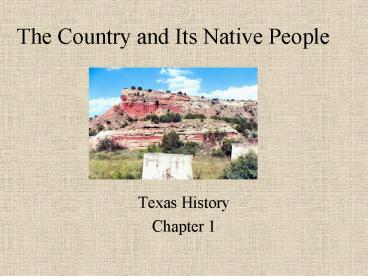Texas History - PowerPoint PPT Presentation
1 / 25
Title:
Texas History
Description:
Native Peoples. Texas Indians. I. Native People of Texas. No dominant Texas Indian culture ... Most European/Anglo-American attempts to 'civilize' the Indians failed ... – PowerPoint PPT presentation
Number of Views:2502
Avg rating:3.0/5.0
Title: Texas History
1
The Country and Its Native People
- Texas History
- Chapter 1
2
I. Types of Landforms in Texas
- Coastal plains
- Prairies
- Deserts
- Mountains
- Hills
- Sandy Beaches
3
II. Faces of Texas
- Mountains- west Texas, Rocky Mountains
- Plains- West, North, Northwest, Gulf Coast
- Plateau- Edwards Plateau, west central part of
state - Hills- eastern part- gently rolling hills,
Central Texas- rugged hills
4
III. Water Resources
- 40 major rivers, 11,000 streams
- Aquifers- 7 major, Edwards
- Lakes- natural and man-made
- 3 River groups
- Rivers flow into Mississippi River- Red, Canadian
- 2. Rivers flow directly into Gulf of Mexico- San
Antonio, Colorado, Trinity, Brazos - 3. Rio Grande and its tributaries
5
IV. Climate
- Elements- Wind direction, temperature, and
precipitation - Precipitation- rain, snow, sleet, hail, mist
- East- Hot and humid during the summer
- Panhandle- Northers- snow, ice, cold wind
- Rainfall- West- dry, East- wet
- Tornadoes and Hurricanes- affect Texas
during spring and summer
6
V. Natural Vegetations
A. Types
- Native Grasses
- Wildflowers
- Trees
- Brush
- Bushes
- Wild Plants
- B. Importance
- Food and shelter
- Prevent erosion
- Make soil fertile
- Makes Texas beautiful
7
- The Regions of Texas
8
I. Gulf Coastal Plains
- Largest region in Texas- wide variety of land and
features - Piney Woods
- Gulf Coast Plains
- South Texas Plains
- Post Oak Belt
- Blackland Prairie
9
II. Central Plains
- Region of gently rolling prairies with forest on
the rivers within the regions - Grand Prairie
- Cross Timbers- East and West
- Rolling Plains
Fort Worth
10
III. Great Plains
- Much of this land is flat, but becomes rugged in
the southern part - High Plains
- Edwards Plateau
11
IV. Rocky Mountains
- One of the most rugged and colorful areas of
Texas. - Mountains and Basins
12
The First Texans
13
I. Studying Prehistory
- Prehistory- before written records
- Archaeologists- dig underneath ground for
evidence of past cultures - Artifacts- tools, weapons, and other objects made
by people - Historians- use the knowledge gained to try to
write a history of the early people
14
Path of migrations of early man from Asia to
North and South America
15
II. Paleo-Indian Era
- 15,000 years ago
- Nomads- searched for food, followed animals
around - Leanderthal Lady- 10,000 years
- Midland Minnie- 8,000 years
- Llano Culture- hunted mammoths and bison
- Folsom Culture- tools made of flint, horns, and
bones , atlatl- spear throwing stick, chased
buffalo off of cliffs
16
III. Archaic Era
- 6,000 B.C.- many animals became extinct, man had
to change - Hunted buffalo, deer, elk, bears,
- Ate berries, nuts, roots, and seeds
- More tools- knives, fishhooks, harpoons
- Domesticate wild animals- dogs
- Planted seeds so they would not have to move
around
17
IV. Formative Era
- 1,000 B.C.
- Pottery and the bow and arrow
- Spread of agriculture (farming)
- Corn, beans, squash, potatoes, pumpkins, tomatoes
- Cultivated cotton and tobacco
- Population increased, people lived longer
- Fewer people needed to grow food- culture began
- Cities began to develop
18
Native Peoples
- Texas Indians
19
I. Native People of Texas
- No dominant Texas Indian culture
- Groups differed greatly from region to region
- Early records of encounters misleading
- Historical understanding of Indian groups largely
incorrect
20
Wichita
Jumano
Attakapans
21
II. Common Practices
- Family organizations and religious beliefs
similar - Believed in supreme being(s)
- Heavy into nature
- Supernatural powers (shaman)
- Marriage monogamous, men could marry more than
one wife - Women did the grunt jobs
- Men hunted, fished, planned for war
22
III. Indian Groups
- Caddoes- East Texas- domelike houses, farmers
- Attakapans- mix of farming and hunting- East
Texas - Karankawas- Gulf Coast- mixture of food, mosquito
repellent, cannibal - Wichita and Tonkawa- Central Texas- buffalo very
important-
23
E. Coahuiltecans- South Texas- smorgasbord of
food, Nomadic, San Antonio area F. Jumanos- Rio
Grande- nomadic, lived in adobe huts G. Apaches-
West Texas- very warlike, nomads, buffalo, H.
Comanche- North and West Texas- High Plains area,
great horsemen, buffalo I. Kiowa- North Texas-
Allies to Comanche
24
IV. Threats to Indian Way of Life
- Indians never united against invaders incursions
- American technology eventually will dominate
- White mans disease- smallpox- will ravage many
Indian tribes
25
V. Indian contributions
- Heritage of Indians still seen today
- Knowledge of land, rivers, etc. helped Europeans
- Part of the 1st four centuries of Texas history
- Helped determine the nature of frontier
institutions - Most European/Anglo-American attempts to
civilize the Indians failed































